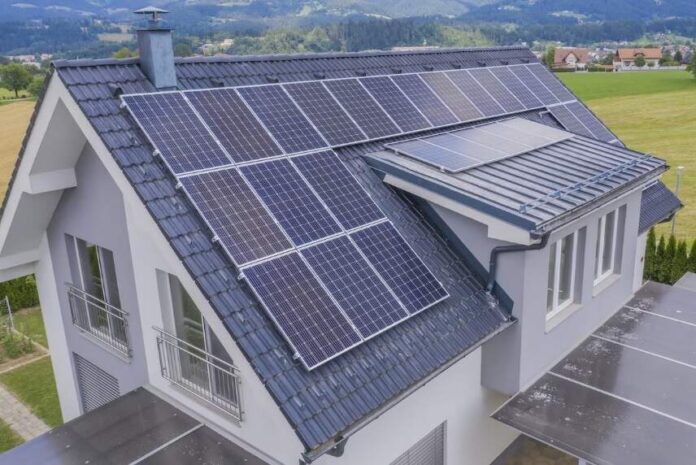Solar shingles provide many of the same benefits as standard solar panels. These include generating renewable energy at home, lowering electricity costs, and being eligible for federal, state, and local solar incentives, rebates, and credits. Homeowners can also expect their homes to increase in value since these sleeker, more attractive roof tiles blend in with the rest of the building.
How They Work
Solar roof shingles are intended to cover or replace conventional roof shingles. They have photovoltaic cells that capture solar energy and convert it to usable electricity. Like traditional solar panels, solar shingles can provide renewable energy, reduce your home’s carbon footprint, and minimize electricity costs. Solar roofing shingles are also typically eligible for the same federal and state solar tax credits as solar panel systems. They can also provide additional savings by generating more energy than your household consumes, allowing you to store the excess in batteries for later use or feed it into the grid in exchange for energy credits. Aesthetics are a major selling point for solar shingles, which blend in more with the roof than traditional solar panels and look like regular asphalt shingles. It makes them ideal for homeowners who want a more integrated solar power solution or live in an area with restrictive homeowner’s association (HOA) rules that prevent solar panel installation.
Maintenance
Solar shingles are an alternative to regular solar panels. They are designed to blend in with other shingles on your roof and don’t require any exposed wiring. Because of this, they are often more appealing to homeowners who may want something other than the look of large panels on their roofs. However, they are also usually more expensive. Solar roofing shingles, also known as building integrated photovoltaics (BIPV), are a newer option for residential solar power. They are a great choice for homeowners who need more space to install solar panels or cannot afford the upfront cost of traditional solar panels. Solar shingles are a relatively new technology, so it is still being determined whether they will live up to their 30-year lifespan. In addition, not all solar installation companies work with these shingles. If you’re interested in a solar shingle project, check with Sunstyle of your chosen product to see if they can work with it.
Materials
Solar shingles and panels generate electricity from sunlight, but their appearance, construction and energy efficiency differ. Solar shingles resemble standard asphalt roof shingles and contain thin layers of photovoltaic (PV) sheets that cover a glass base. They can be placed on top of existing shingles or replaced completely and are designed to withstand the same weather conditions as regular roofs. The solar shingle surface is coated with a material that naturally knocks off electrons when exposed to sunlight. The free electrons flow through the shingles and into an inverter, where they are converted to direct current. The direct current can then be used by your home, stored in a battery bank or fed back into the electric grid. Most solar shingles use CIGS cells made from copper indium gallium selenide, a natural semiconductor. However, some use monocrystalline silicon, also used in traditional solar panels and offers a higher conversion efficiency rate.
Installation
Solar shingles are nailed directly to your roof, unlike solar panels which require special mounting racks and brackets. It streamlines the installation process and eliminates potential hazards from external wiring. Solar shingles also look less like traditional solar panels and have greater curb appeal, which could make them more appealing to homeowners. However, they have higher upfront costs and lower energy efficiency than solar panels. Solar shingles can use traditional silicon photovoltaic cells or copper-indium-gallium-selenide (CIGS) thin film technology, depending on the brand. CIGS is the latest innovation in solar shingle production and offers a more flexible, lighter shingle that can blend in with your existing roof material. Most shingle brands have efficiencies in the low to high teens; this is less efficient than solar panel technology available today, which can reach up to 22 or 23 percent. It may be a small deal for some homeowners, but it’s important to consider before choosing this type of installation.


